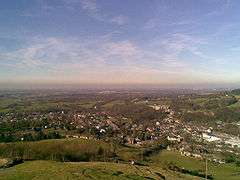Please tell us which country and city you'd like to see the weather in.

Little Bollington
Coordinates: 53°22′34″N 2°24′32″W / 53.376°N 2.409°W / 53.376; -2.409
Little Bollington is a village and civil parish in Cheshire, England. The Bridgewater Canal runs through the western side and Dunham Park lies to the north east.
In 2001, the population was 162. In place of a parish council, administration takes place via a parish meeting.
History
At Fairy Brow in Little Bollington, there is evidence of Bronze Age activity. An archaeological dig by South Trafford Archaeological Group was carried out in 1983. The excavation uncovered an oval, Bronze Age burial pit. In the burial were cremated remains with a tanged knife, approximately 8 cm long; the remains were radio carbon dated to about 1500 BC, the knife was most likely contemporary. According to the Domesday survey in 1086, the manor of Little Bollington was held by the Saxon thegn Aelfward and later by the Norman Hamon de Mascy. The northern part of Little Bollington was in the medieval parish of Bowdon.
Demography

Bollington
Coordinates: 53°17′53″N 2°05′35″W / 53.298°N 2.093°W / 53.298; -2.093
Bollington is a small town and civil parish in Cheshire, England, to the east of Prestbury. In the Middle Ages it was part of the Earl of Chester's manor of Macclesfield, and the ancient parish of Prestbury. In 2001, Bollington had a population of 7,095. (7593 in 2011 census)
Bollington, locally nicknamed "Happy Valley", is on the River Dean and the Macclesfield Canal, on the south-western edge of the Peak District. Rising above the town is Kerridge Hill that is surmounted by White Nancy, a monument built to commemorate the Battle of Waterloo in the Napoleonic Wars.
Bollington is twinned with Thurles in County Tipperary, Ireland.
History
In the 19th and 20th centuries, Bollington was a major centre for cotton spinning. The Waterhouse Mill, now demolished, off Wellington Road, once spun the finest cotton in the world, and was sought after by lace makers in Nottingham and Brussels.
Clarence Mill still stands and has since been converted into luxury apartments. One of the oldest surviving mills in Bollington is the very small Defiance Mill, built in Queen Street about 1800 and also now restored for residential occupation.
Radio Stations - Little_Bollington
SEARCH FOR RADIOS
Podcasts:

